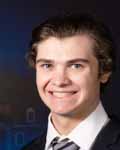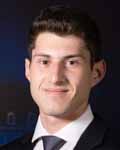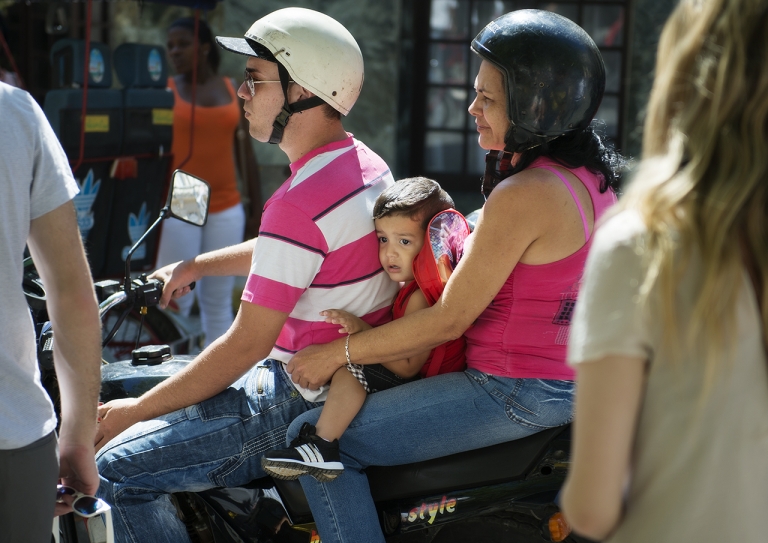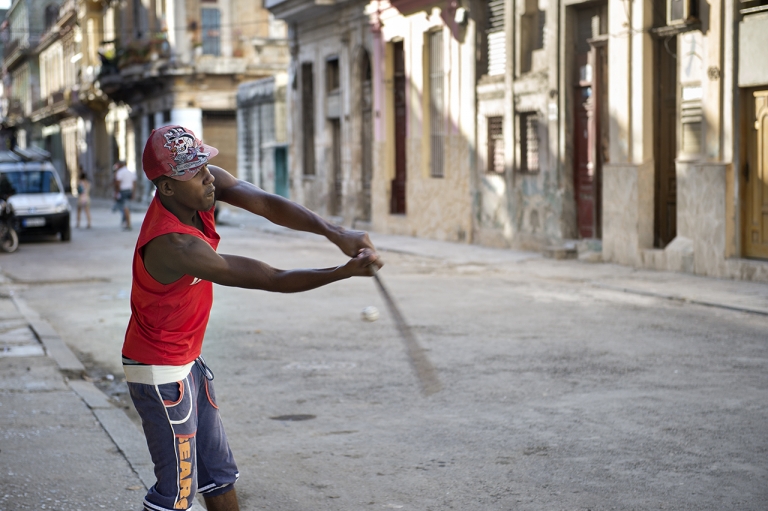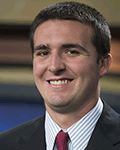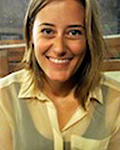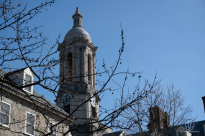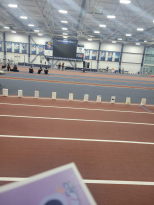Live from Cuba
Though only 90 miles from the coast of Florida, few Americans have the opportunity to visit Cuba. Students in the College of Communications' International Reporting class are spending 10 days in Havana, March 7-16, 2014 reporting on life the country's capital.
Students will produce stories based on their trip that will be posted later in the spring. Daily photos, and stories will be posted here over the course of the trip.
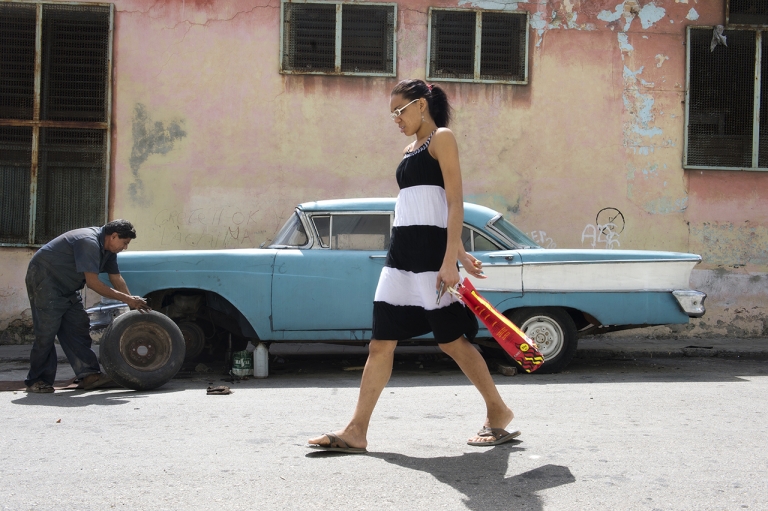 Reynaldo Rodriguez works on a 1958 Ford Edsel Friday in central Havana.
Reynaldo Rodriguez works on a 1958 Ford Edsel Friday in central Havana.
~ Photo by Kelly Tunney
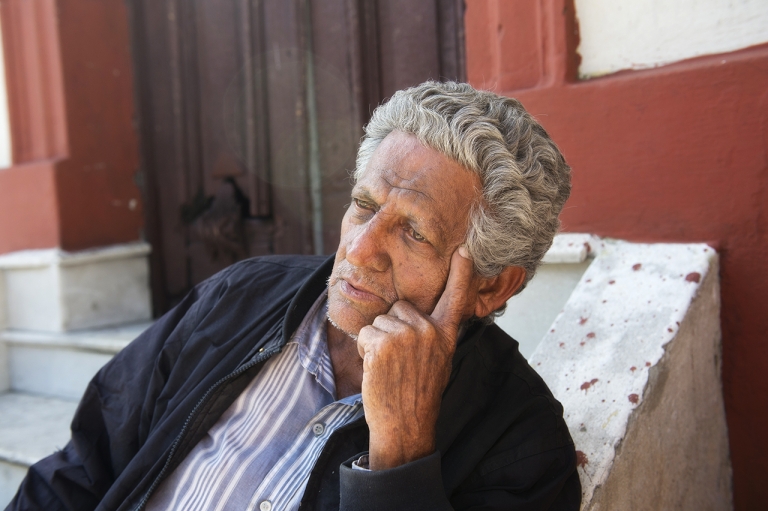
Nicholas Hernandez, 70, sits on the stoop in central Havana on Friday ~ Photo by Kelly Tunney
There’s one famous Cuban who isn’t.
Ernest Hemingway spent many of his later years living in Cuba. While his home (now a museum) is outside Havana, many of his favorite haunts are within the city.
First and foremost is a bar called la Floridita, which now doubles as a site of pilgrimage for Hemingway fans. The bar is in Old Havana, and Hemingway declared it home to the greatest daiquiri ever made.
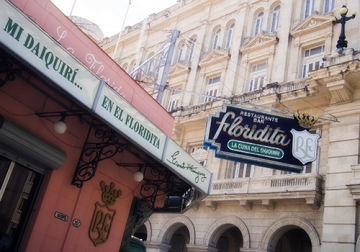
Daiquiris are $6. Tour groups shuffle in and out. On Sunday, a man put his finger in the Hemingway statue’s nostril and stuck his tongue out while posing for a photo.
While it used to be a dive bar, photos of Hemingway adorn the walls, a live salsa band plays and a gold statue of the author sits at the bar in the corner. Tourists take photos of them all.
In short, it’s become a bar Hemingway wouldn’t care for today.
~ by Noelle Mateer
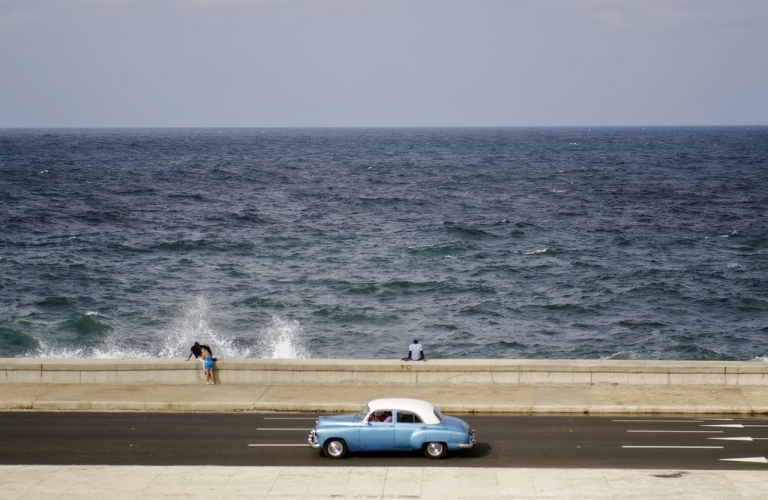
One of the many pre 1959 American cars that still run in Havana speeds along the Malecón. ~ Photo by Jessica Paholsky
There is more to Cuban food than pork, chicken, beans and rice. You can find seafood dishes of mahi mahi, tuna, shrimp and lobster.
Paladares (private restaurants) produce some of the best food on the island. Appetizers such as potato rings filled with hot sauce and entrees that include generous portions of chicken marinated in garlic sauce and red wine grace the table of Nao, a paladar in Havana, all for about $10.
Other paladares including one owned by the retired chef of Fidel Castro serve dishes that include duck, veal, shrimp marinated in garlic and shredded beef. The seafood (especially lobster) has been fresh, while some of the meat dishes such as the shredded beef have been bursting with flavor. Despite the common notion that Cuban food is spicy, that notion could not be further from the truth.
The paladares are small, welcoming places that all share a relaxed atmosphere. A surf and turf meal consisting of duck, veal, chicken, shrimp and lobster at one of the restaurants was about $17, affordable for tourists but out of the price range of most Cubans.
~ by Willie Jungles
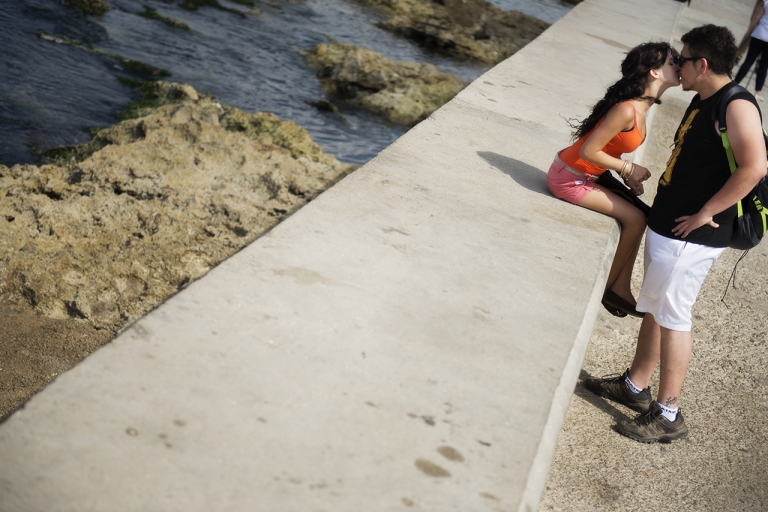 A couple shares a kiss along the Malecón. ~ Photo by Jessica Paholsky
A couple shares a kiss along the Malecón. ~ Photo by Jessica Paholsky
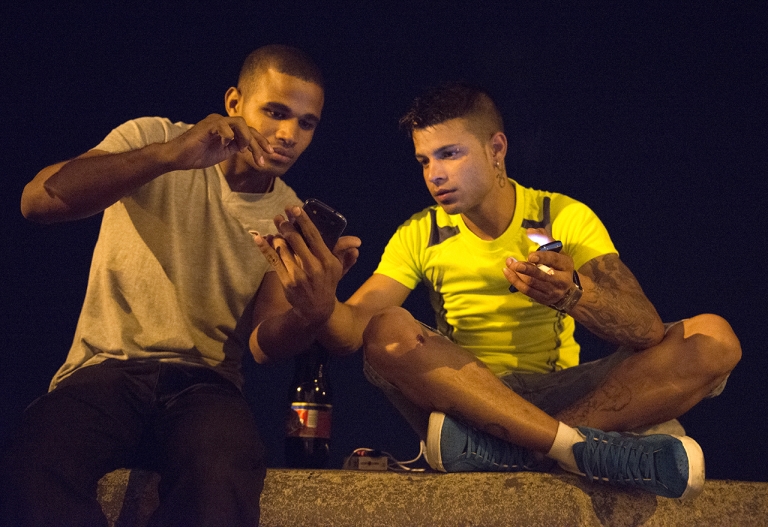 Alen Emil, 26, right, of Germany and Gerardo Tamayo-Aula, 33, left, of Havana, hang out on the Malecón Tuesday night. They go to sit along the ocean to people watch for four or five hours at a time. ~ Photo by Jessica Paholsky
Alen Emil, 26, right, of Germany and Gerardo Tamayo-Aula, 33, left, of Havana, hang out on the Malecón Tuesday night. They go to sit along the ocean to people watch for four or five hours at a time. ~ Photo by Jessica Paholsky
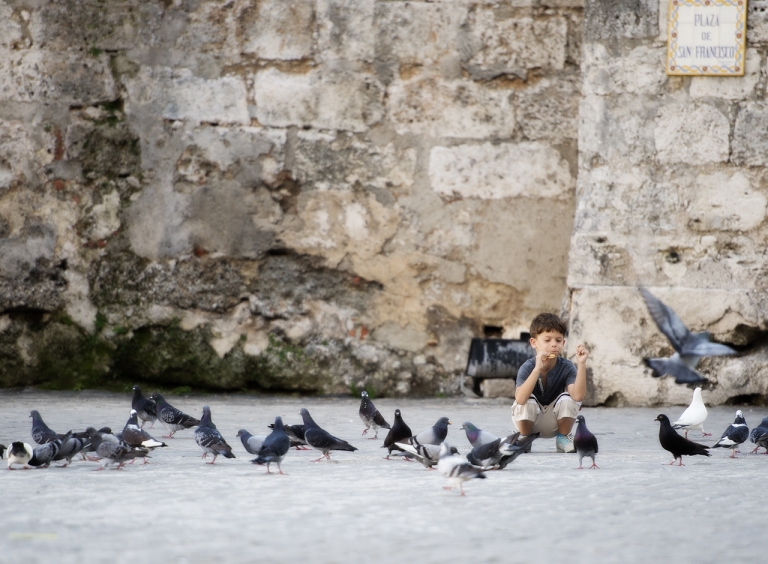
The Plaza de San Francisco in Old Havana on Tuesday evening. Old Havana is the tourist center of the city. ~ Photo by Kelly Tunney
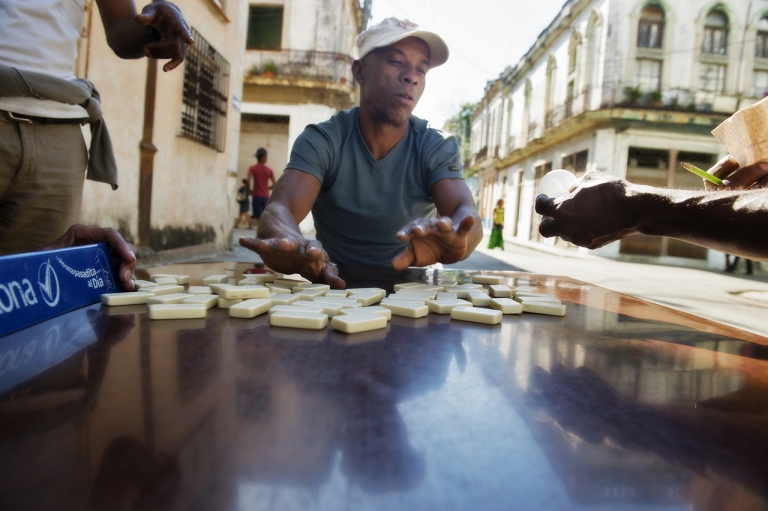
Raúl Lemos plays dominos in Old Havana on Tuesday March 11, 2014. ~ Photo by Kelly Tunney
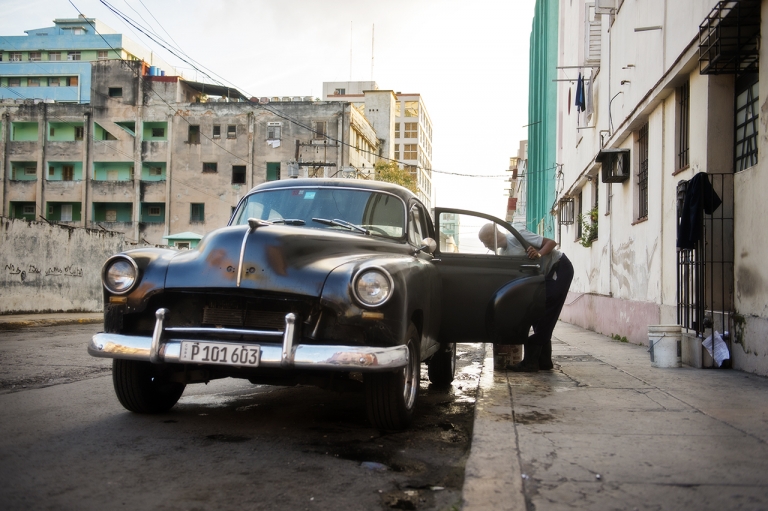
Francisco Rodriguez earns four Cuban pesos for washing cars. Because of the U.S. embargo, the only American cars in Cuba date from before the country's 1959 revolution. They have become a popular tourist attraction and are often used as taxis in Havana. ~ Photo by Kelly Tunney
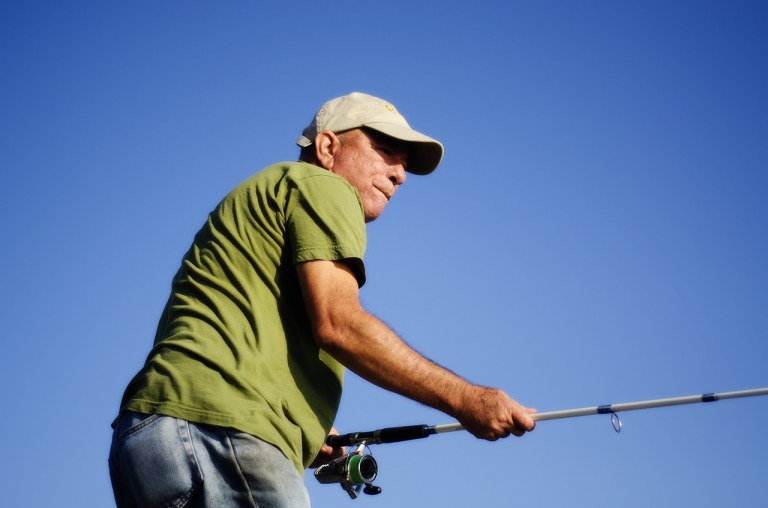 Fidel "Pototo" Lopez, 57, casts his fishing pole from the Malecón wall just after dawn on Sunday. Lopez fishes daily, but he said he catches one or two fish a week. According to him, the Malecón is a meeting point for fishermen, lovers and musicians. ~ Photo by Jessica Paholsky
Fidel "Pototo" Lopez, 57, casts his fishing pole from the Malecón wall just after dawn on Sunday. Lopez fishes daily, but he said he catches one or two fish a week. According to him, the Malecón is a meeting point for fishermen, lovers and musicians. ~ Photo by Jessica Paholsky
A hit is a hit, and an out is an out regardless of politics, history or embargoes.
The infield field is a patch of dirt, almost in the shape of a diamond. No baselines, no mound, no backstop. Rocks the size of a baseball glove mark first, second and third base. Home plate is a black rubber slab in its traditional shape. The outfield grass is uneven. A passed ball, foul ball or errant throw often ends up in the middle of the Malecon, one of the busiest streets in Havana.
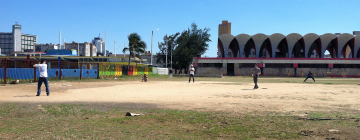
The kids playing appeared to be from nine to thirteen-years-old. A few dads were there as well (two of them playing, one of them was the umpire). Not everyone had a hat, nobody wore batting gloves, and the shortstop for one of the teams wasn’t wearing shoes. There were no more than five mitts between the two teams and just two bats and one ball. Between innings a fielder coming off who was lucky enough to have a glove would toss his mitt to a fielder coming on.
The umpire asked me where I was from. I responded, “The United States.” He smiled and said something in broken English about the Yankees. He then pointed to various players on the field while saying names like Derek Jeter or Alex Rodriguez.
Eventually two players had to leave. The umpire pointed to fellow Penn State student Eric Deberardinis and me and invited us to take the two players’ spots.
We walked over to the cement blocks behind home plate where the players sit. Next thing I know, Eric is pitching and I’m on deck.
I introduced myself, but for most of the day they would call me “America.” Eric was “Pitcher.”
I stepped up to the plate. The bat is small for me. I take a cut and hit a grounder in the hole over towards shortstop for an infield hit. Though first base is a rock, it’s not too different than playing a pickup game of stickball in the street.
The inning ends and Eric comes up to bat. He tees off on a pitch and hits a shot to deep left field. In his next at-bat, the pitcher would brush him off the plate multiple times and throw him curveballs and knuckleballs.
They throw me a glove and I put it on my hand it was like wearing a tight, floppy oven mitt. They had used shoelaces, twine and what appeared to be strips of a plastic bag wound tightly enough to hold the glove together.
The game ended a few innings later and the umpire came over to me, shook my hand and gave me a hug. We shook hands with all of the other players, said our round of “adios” and “muchas gracias” and left.
~ by Alex Eliasof
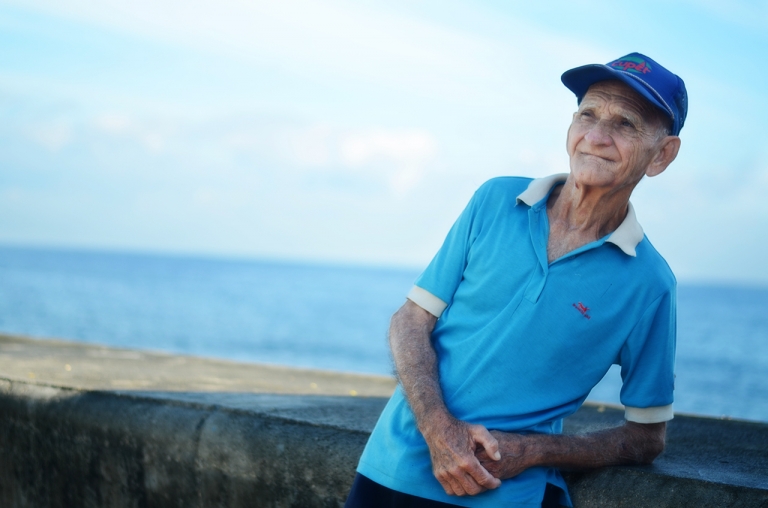
Luis Pozo Penin leans on the wall along the Malecón in Havana, Cuba on Sunday. Pozo Penin, 76, is a Havana native. After retiring he decided to return to work and is presently employed in the service sector. The Malecón is a coastal walkway popular with locals and tourists that borders the capital city of Havana. ~ Photo by Jessica Paholsky
Professor Arnaldo Coro walked into his bedroom on Sunday afternoon and took a seat at his desk. There were two computers. One looked like it had been ravaged for parts years ago. A 15" CRT monitor stood next to it – a sign of what was and what is in use in Cuba today. Coro said it works as a backup in case something happens to his primary computer.
Next to that older computer was a second one – assembled from parts he purchased, or that people left for him when they visited his home. This computer still looked past its prime and was clearly assembled from a variety of different pieces. Together, they allowed Coro to have a computer in his home – an exception rather than the norm in Cuba.
He is one of the few people in Cuba who has access to the internet in his home. Cuba has one of the lowest internet penetration rates in all of Latin America. The internet is slow and expensive. Coro said, "[the internet] is as slow as a Galapagos turtle."
It's also expensive. Many citizens can't afford to pay for even one hour of access.
As Coro sat down, he typed in www.washingtonpost.com.
He waited. And waited. A minute and a half went by before the first sign of the Washington Post's homepage came up.
The country as a whole still feels unplugged from the outside world, but if Coro's home is any indication, there is the possibility that this country will eventually be connected to the world just miles away.
~ by Christian Heilman
A scooter zips along a crowded street in Old Havana on Saturday. The tourist industry is a bright spot in the Cuban economy and Old Havana is full of new restaurants, shops and throngs of tourists. ~ Photo by Kelly Tunney
Frankial Oliva, 15, swings at a pitch in a stickball game on Refugio Street between Consulado and Prado avenues in Old Havana. The boys were playing with a broom handle and a golf ball-sized wad of cloth, alternating batter and pitcher whenever someone made a hit. ~ Photo by Kelly Tunney

